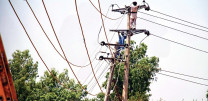Shahi Mosque: Chiniot’s timeless glory
The mosque is set on a single-storey podium with perimeter shops.

Shahi Mosque: Chiniot’s timeless glory
The mosque is set on a single-storey podium with perimeter shops. To add beauty to the structure, the external façades are distinguished by their prominent decoration and by the four corner towers. The internal court has an ablution pool and three domes over a gallery bordering the prayer hall.

Almost all salient features of Muslim architecture are fully reflective in the construction of Shahi Mosque, which because of its artistic skill and calligraphic dexterity seems remarkable even today. A few years ago, when the government started conservation of the Shahi Mosque, local craftsmen with expertise were hired while original materials were used to restore the building and artwork on the walls. It was an effort to redefine the original structure, details and settings.
Dates to remember
- 1648 - Foundation stone of the mosque was laid down
- 1655 - Construction of the Shahi Mosque was completed
- 1816 – The mosque was used as stable by Sikh ruler Ranjeet Singh
- 1857 - Imam of the mosque Noor Ahmad was arrested over charges of instigating the masses against British Rule
- 1655 - Founder of the mosque Saadullah Khan died
- 1956 - Formulation of administrative committee of the mosque
- 1960 – The mosque was handed over to Auqaf Department
- 1963 - Repair and restoration plan of the mosque was undertaken
- 1972 - Reconstruction work started under patronage of Waliullah Khan
- 1978 - Mosque was opened to public after restoration
Published in The Express Tribune, May 1st, 2017.



















COMMENTS
Comments are moderated and generally will be posted if they are on-topic and not abusive.
For more information, please see our Comments FAQ